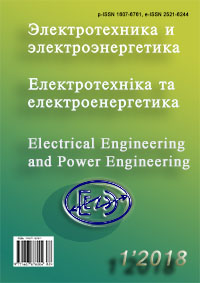CONTROLLING THE ELECTROCHEMICAL ENERGY STORAGE CHARGING PROCESS
DOI:
https://doi.org/10.15588/1607-6761-2018-1-5Keywords:
electrochemical energy storage, response signal, current state, control, algorithm, charging process, electrochemical processAbstract
Purpose. Substantiation of the impulse galvanostatic method of monitoring and controlling the process of charging an electrochemical energy storage device based on a lead-acid electrochemical system, and developing an algorithm for its implementation.
Methodology. The investigations using the pulse method of automated monitoring the energy storage device current state, in which the values of the informative parameters are determined from the storage response signal to the current test pulse, and the charging process is controlled according to the developed algorithm taking into account the current state of the storage device, were carried out.
Findings. The developed method of monitoring and controlling the process of storage charging and the algorithm for its implementation allow to reduce the storage charging time in comparison with the galvano-potentiostatic method. Information about the dynamics of the charging process is displayed on the monitor screen, which allows visually monitoring the storage charging process and record the completion time.
Originality. The authors substantiate the impulse galvanostatic method of monitoring and controlling an electrochemical energy storage device charging process, in which the parameters of the electrochemical process in the storage reflecting it’ s current state are used as informative parameters for the charging process .
Practical value. An algorithm for the implementation of a method for monitoring and controlling the process of an electrochemical energy storage device charging, which can be used to provide an optimal charging regime for energy storage devices in autonomous photovoltaic power supply systems has been developed.
References
[1] Gruzdev, A. I. (2008). Osnovnye tendencii i napravlenija razvitija avtonomnoj jelektrojenergetiki Ch. II., Jelektrichestvo, 10, 2 – 11. [in Russian].
[2] Kamenev, Ju. B., Chunc, N. I. (2005). Rezhim zarjada germetizirovannyh cikliruemyh svincovo – kislotnyh akkumuljatorov, (№ 4). Jelektrohimicheskaja jenergetika, 4, 226 – 273. [in Russian].
[3] Taganova, A. A., Bubnov, Ju. I., Orlov, S. B. (2005). Germetichnye himicheskie istochniki toka, M, Himizdat, 262.
[4] Kamenev, Ju. B., Lushina, M. V., Vasina, I. A. (2008). Rabota svincovo-kislotnogo akkumuljatora v uslovijah postojannogo nedozarjada, Jelektrohimicheskaja jenergetika, 8, 3, 146 – 151. [in Russian].
[5] Aguf, I. A., Dasojan, M. A., Lyzlov, N. Ju. (1984). Konstrukcija i uslovija jekspluatacii germetichnogo svincovogo akkumuljatora, M, Informjelektro, 2, 6–29.
[6] Koshel', M. D. (2002). Teoretichnі osnovi elektrohіmіchnoї energetiki, Pіdruchnik. Dnіpropetrovs'k, UDHTU, 430.
[7] Gindelis, Ja. E. (1984). Himicheskie istochniki toka. Saratov, Saratovskogo universiteta, 174.
[8] Kamenev, Ju. B., Shtompel', G. A., Chunc, N. I. (2012). Uskorennyj metod zarjada svincovokislotnogo akkumuljatora 1. Gal'vanostaticheskij jetap zarjada, Jelektrohimicheskaja jenergetika, 12, 2, 64–71. [in Russian]
[9] Dzenzerskij, V. A., Zhitnik, N. E., Plaksin, S. V. Sokolovskij, I. I. (2005). Kontrol' sostojanija starternyh svincovyh akkumuljatorov hronopotenciometricheskim metodom, Electrical Engineering And Power Engineering,, 1, 13 – 18.
[10] Kamenev, Ju. B., Shtompel', G. A., Skachkov, Ju. V. (2013). 1. Uskorennyj metod zarjada svincovokislotnogo akkumuljatora 2. Gal'vanostaticheskij zarjad. Jelektrohimicheskaja jenergetika, 13, 2, 70 – 76. [in Russian]
[11] Podrazhanskij, Ju. M. (2000). Ispol'zovanie impul'snyh rezhimov zarjada dlja povyshenija jekspluatacionnyh parametrov akkumuljatorov, avtoref. dis. kand. tehn. nauk, 05.17.03 . D, Ukrainskij gos. himiko-tehnologicheskij un-t, 17.
[12] Volkіvs'kij, V. B. (2007). Napіvprovіdnikovі peretvorjuvachі z pіdvishhenoju efektivnіstju zarjadu akumuljatorіv іmpul'snimi asimetrichnimi strumami: dis. kand. tehn. nauk, 05.09.12, Nacіonal'nij tehnіchnij un-t Ukraїni «Kiїvs'kij polіtehnіchnij іnst», 163.
[13] Kamenev, Ju. B., Shtompel', G. A. (2013). Uskorennyj metod zarjada svincovo-kislotnogo akkumuljatora. 3. Impul'snyj zarjad, Jelektrohimicheskaja jenergetika, 13, 2, 77 – 82. [in Russian]
[14] Dzenzersky, V., Zhitnik, N., Plaksin, S., & Lisunova, V. (2017). Development of the algorithm of automated control of electrochemical energy storage devices. Electrical Engineering And Power Engineering, 1, 39-47. doi: http://dx.doi.org/10.15588/1607-6761-2017-1-6
[15] Plaksin, S. V., Zhitnik, N. E., Shirman, O. I. (2012). Jeksperimental'nyj stend dlja avtomatizirovannogo kontrolja sostojanija himicheskih istochnikov toka impul'snym metodom, Gіrnicha elektromehanіka ta avtomatika, 89, 58 – 63.
[16] Dzenzersky, V., Plaksin, S., Zhitnik, N., & Pogorelaya, L. (2009). Method of charging chemical sources of current in the composition of photoelectric installation. Electrical Engineering And Power Engineering, 2, 73 – 77.
Downloads
Published
How to Cite
Issue
Section
License
Copyright (c) 2018 DZENZERSKY V. O., ZHITNIK N. E., PLAKSIN S. V., LISUNOVA V. V.

This work is licensed under a Creative Commons Attribution 4.0 International License.
Creative Commons Licensing Notifications in the Copyright Notices
Authors who publish with this journal agree to the following terms:
Authors retain copyright and grant the journal right of first publication with the work simultaneously licensed under aCreative Commons Attribution License that allows others to share the work with an acknowledgement of the work's authorship and initial publication in this journal.
Authors are able to enter into separate, additional contractual arrangements for the non-exclusive distribution of the journal's published version of the work (e.g., post it to an institutional repository or publish it in a book), with an acknowledgement of its initial publication in this journal.
Authors are permitted and encouraged to post their work online (e.g., in institutional repositories or on their website) prior to and during the submission process, as it can lead to productive exchanges, as well as earlier and greater citation of published work.

